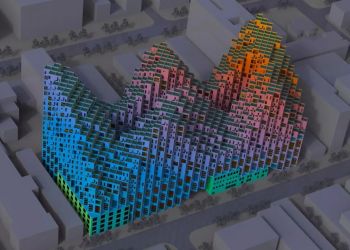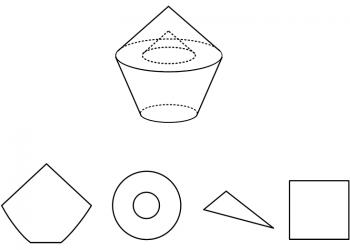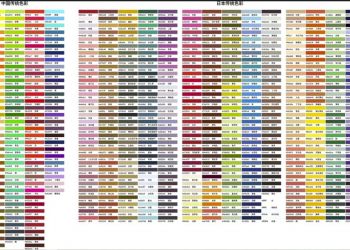马上注册,结交更多好友,享用更多功能,让你轻松玩转社区。
您需要 登录 才可以下载或查看,没有账号?立即注册
×
本文已简要翻译,点击查看翻译版
The art and science pavilions by Lab Architecture Studio in collaboration with Chris Yiu-hang Chan and Stephanie Mee-lee Tan were recently completed in Wujin, China. The project won first prize in the 8th China Flower Expo competition, which aims to promote sustainable design. The composition of the project was inspired by flower petals floating on water, while the forms of each pavilion reflect the surrounding natural landscape in West Tai-hu Lake. Although similar in aesthetics, each pavilion was designed according to its own exhibition functions. Photos and additional details on this winning project are right below.

Click above image to view slideshow
Aerial view of the Art and Science Pavilions by Lab Architecture Studio + Chris Yiu-hang Chan and Stephanie Mee-lee Tan. Photo: Ryuji Miya. Image courtesy of Chris Y.H. Chan
Project description "Located on the West Tai-hu Lake, the design for the 8th Chinese Flower Expo pavilions explores the aesthetics of the relationship between the water and the petal. Also experiment the tension between the Natural landscape and the iconic culture body. The designs of the two related pavilions (Art Exhibition Pavilion, Science Exhibition Pavilion) draw upon the natural geographical features of the area and use ecological building design principles to improve the relationship between art, architecture, and the environment whilst furthering the Flower Expo building society’s view to promote sustainability and the natural ecology." 
Click above image to view slideshow
A view of the art and science pavilions at dusk. Photo: Ryuji Miya. Image courtesy of Chris Y.H. Chan
"To create a performance orientated building as the very primitive intention, both pavilions have a 140 + meter expanse of sweeping, curvilinear forms constructed of tri grid steel members; with more than 8000 control points (5000+ for science pavilion, 3800+ for art pavilion), in association with highly translucent ETFE weatherproof membrane, shielding the 2-storey exhibition halls underneath, which could reduce the heat gains during mid-noon in summer. The zigzagged in house façade promotes the possibility of passive ventilation in the galleries." 
Click above image to view slideshow
Art pavilion. Photo: Ryuji Miya. Image courtesy of Chris Y.H. Chan
"The pavilions, both the Art Exhibition Pavilion and Science Exhibition Pavilion, operate as twinned, but separate sites, following similar formal expressions, but different planning and accommodation arrangements, as befits their different exhibition sequences. The Art Exhibition Pavilion is more enclosed and intimately focused, with smaller displays and objects for viewing and study. The Science Exhibition Pavilion displays projected films and animations, relying on larger, audience interactive forums and spaces. Both Pavilions following curvilinear arrangements, with the entering and exiting flow of visitors at the scale of a major expo of primary concern." 
Click above image to view slideshow
Science pavilion. Photo: Ryuji Miya. Image courtesy of Chris Y.H. Chan

Click above image to view slideshow
Art pavilion courtyard. Photo: Ryuji Miya. Image courtesy of Chris Y.H. Chan
"The monocoque creates an in-between space for people enjoy the surrounding natural scene within the building. It is responds the simple self-spin gallery profile and beautiful natural landscape to enhance the experience and interactive opportunity during the journey." 
Click above image to view slideshow
Art pavilion monocoque. Image courtesy of Chris Y.H. Chan

Click above image to view slideshow
Science pavilion monocoque. Image courtesy of Chris Y.H. Chan

Click above image to view slideshow
Courtyard space. Photo: Ryuji Miya. Image courtesy of Chris Y.H. Chan
"The planning and configuration for both comes from loops and overlapping ellipses. This concept includes the indoor, outdoor courtyard and transition space. Both pavilions could trace out a single round pattern as very primitive iconography. And this notion indeed absorb Chinese spacial concept - Architecture is not only inside; nor outside; and never a mono-object. That is body/mechanism of inclusive outdoor, indoor and in-between. The entire petal-like composition of the project responds visually and tectonically to its environment to create a distinct and powerful sense of place as well as a breathtaking backdrop for the 8th Chinese Flower Expo." 
Click above image to view slideshow
Night view of art pavilion. Photo: Ryuji Miya. Image courtesy of Chris Y.H. Chan

Click above image to view slideshow
Night view of science pavilion. Photo: Ryuji Miya. Image courtesy of Chris Y.H. Chan

Click above image to view slideshow
3D theater inside science pavilion. Photo: Ryuji Miya. Image courtesy of Chris Y.H. Chan
Project data Project name: Pavilion of Art + Pavilion of Science, The 8th China Flower Expo (Competition 1st Prize)
Architect: Lab Architecture Studio in collaboration with Chris Yiu-hang Chan & Stephanie Mee-lee Tan
Location: Wujin, China
Year of completion: 2013
Function: Exhibition gallery + multimedia center Architect in charge: Donald L. Bates, Andy Wang, Chris Y. H. Chan, Stephanie M. L. Tan
Project team: Ryuji Miya, Irene Yang, Ada Ou, Shayne lacy
Local Design institute: Shanghai Sunyat Architecture Design Co.,Ltd Photography: Ryuji Miya, Gary Images courtesy of Chris Y.H. Chan.

Ground plan: art pavilion. Image courtesy of Chris Y.H. Chan

Ground plan: science pavilion. Image courtesy of Chris Y.H. Chan
| 
 Rhino建模渲染必备插件合集34255 人气#工具软件
Rhino建模渲染必备插件合集34255 人气#工具软件 中央机关及其直属机构2026年度考试录用公务909 人气#公务员考试
中央机关及其直属机构2026年度考试录用公务909 人气#公务员考试 PSD真实人物素材以及汽车素材。5876 人气#PS素材库
PSD真实人物素材以及汽车素材。5876 人气#PS素材库 色卡大全,应有尽有。想攒点米粒6703 人气#PS素材库
色卡大全,应有尽有。想攒点米粒6703 人气#PS素材库